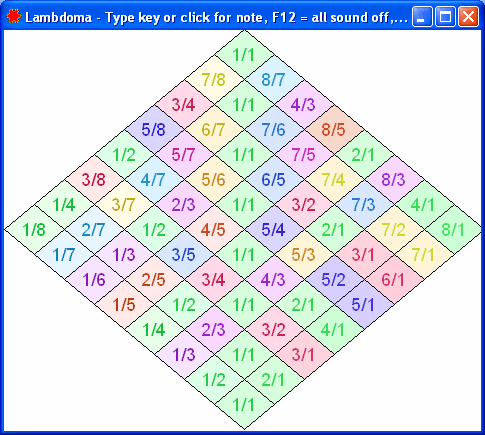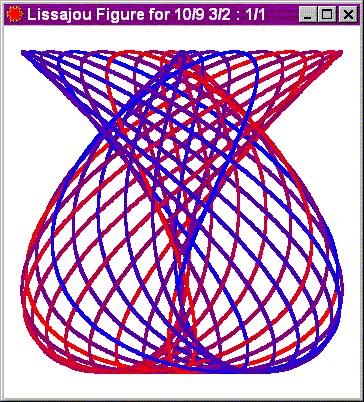Lambdoma Music Therapy
The Lambdoma View is one of the many features that come as part of Tune Smithy
Tune Smithy is used to help realise Barbara Hero's Lambdoma music therapy ideas. If you want to play Barbara Hero's Lambdoma keyboard, you will need to download Tune Smithy. If you do not have Lambdoma keyboard, you can also explore it from within Tune Smithy, by using the mouse, PC keyboard, or ordinary music keyboard.

Screen shot (doesn't play notes)
The Lambdoma view on Fractal Tune Smithy is an on-screen version of Barbara Hero's Lambdoma keyboard. It lets you play the harmonious pitches of the Lambdoma array used in music therapy. In addition Fractal Tune Smithy can show the beautiful Lissajous figures associated with the chords you play.
Why the lambdoma array of pitches is so harmonious
This diamond array of pitches is based on the harmonic series. Harmonic series notes sound particularly mellow together. When you sing equal tempered pitches then you get a fast wah wah type beat pattern superimposed on many chords - the general effect is a little rough, and buzzy and exciting. The harmonic series pitches give a more relaxed mellow type of chord. A capella choirs often sing harmonic series pitches in long held chords.
The rows running up diagonally to the right are harmonic series pitches, also known as the overtone series. Any pitches in the same overtone series sound well together. To explain the ratio notation - you can set the 1/1 on the keyboard to any pitch you prefer, say middle C. Then 2/1 will be double that pitch, 3/1 is three times that pitch and so on. The rows running diagonally up to the left are subharmonic pitches, also known as the undertone series 1/1 1/2 1/3 ... Those also sound well together. Chords with pitches in the overtone series are overtonal chords - or otonal for short. When the pitches are in the undertone series they are known as utonal.
So if you play a chord of notes all in the same diagonal row or column, then you get a harmonious chord. Some are similar to the classical chords we know - the 1/1 6/5 3/2 chord for instance is the undertone series version of the minor chord. The 1/1 5/4 3/2 is the overtone series major chord - these are chords that get sung by A Capell choirs. However this pattern of pitches also includes harmonies that are never heard in classical Western music, for instance ones that use the seventh harmonic. This picture shows the first quadrant - the other quadrants of Barbara Hero's keyboard use even higher harmonics - the exotic eleventh and thirteenth harmoncs.
The Lissajous patterns and their association with harmonies
You can also show a Lissajous pattern corresponding to the frequencies in the chords you play. Lissajous was a nineteenth century Frenchman and he made the beautiful patterns that now bear his name using mirrors attached to tuning forks - these reflected a spot of light that traced the Lissajous figure through persistence of vision. They can also be made using oscilloscopes or pendulums. Barbara Hero has explored Lissajous patterns generated directly from the sounds played. However the ones you create with Fractal Tune Smithy are calculated from the intended frequencies of the pitches, rather than created from the actual sounds produced - they are ideal Lissajous patterns as it were.
Here is an example:

The pattern changes as you play different combinations of notes on the keyboard. For more examples see the Lissajous images page.
Barbara Hero's music therapy approach using the Lambdoma
The Lambdoma pattern of pitches dates back to Pythagorous. Barbara Hero has explored it and developed approaches for music therapy using this pattern. She uses it with a sustained drone note played on one speaker, and the Lambdoma notes played on another. Her methods have helped many patients suffering from shock, trauma and other conditions of the type that respond to music therapy. She makes a hardware keyboard that you can use to play these pitches, which works by playing the notes on a p.c. running Fractal Tune Smithy. As you play the notes on the keyboard, the corresponding cells light up on the on-screen display of the Lambdoma, and you hear the pitches on your computer. To find out more visit her site: Lambdoma
However you don't have to buy her keyboard to explore the lambdoma harmonics, as you can also use Fractal Tune Smithy on its own with your mouse and p.c. keyboard to explore the Lambdoma keyboard pitches. Either for health and well being or out of interest. The Lambdoma harmonics are of especial interest also to modern microtonal composers, some of whom compose using the ideas pure "just intonation" harmonic and sub harmonic chords such as these ones. The infinite Lambdoma, also known as the Tonality Diamond is one of the arrangements of pitches that microtonal composers use in their work.
Special note for music therapists
The particular way that the Lambdoma is presented in FTS is done with Barbara Hero's permission, approval and overview at every stage in the programming. That is to say the four quadrants, the use of the drone for healing, the colour coding, the association with Lissajous patterns, and other such features are all her ideas. So one should be aware that this section of FTS uses her ideas and if you want to use similar ideas to develop your own music therapy based healing methods and you want to take on clients of your own using the healing methods you develop, you should probably contact Barbara Hero and consult with her and make sure that it is okay to develop her ideas in that way.
Freeware / Shareware status:
This feature is shareware You are recommended to try out the program first. If you decide to purchase, you need to buy the Midi Relay level.
top
To continue reading about Tune Smithy, go on to the Lissajous patterns
To find this feature after you download Tune Smithy:
Look in the Tune Smithy Tasks window for: 
The program comes with a Free Test drive with all the features completely unlocked (start the test drive at any time):
Download Tune Smithy
Or if you plan to use it mainly for music therapy, get it from the Tune Smithy download page for the Lambdoma.
top
|